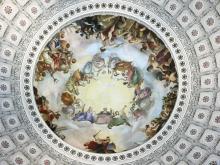This painting, The Apotheosis of Washington, is painted in the eye of the Rotunda of the U.S. Capitol -- directly overhead, in the top of the dome. It is a fresco, meaning that it was painted directly into wet plaster. This technique was widely used during the Italian Renaissance, most famously by Michelangelo in the Sistine Chapel.
The fresco was painted in 1865 by Constantino Brumidi. Brumidi (1805-1880) was born and trained in Rome and had painted in the Vatican and Roman palaces before emigrating to the United States in 1852. A master of creating the illusion of three-dimensional forms and figures on flat walls, Brumidi painted frescoes and murals throughout the Capitol from 1855 until his death. The canopy fresco, his most ambitious work at the Capitol, was painted in eleven months at the end of the Civil War, soon after the new dome was completed, for $40,000. Suspended 180 feet above the Rotunda floor, it covers an area of 4,664 square feet. The figures, up to 15 feet tall, were painted to be intelligible from close up as well as from 180 feet below. Some of the groups and figures were inspired by classical and Renaissance images, especially by those of the Italian master Raphael.
Interpreting the painting
The word apotheosis means literally the raising of a person to the rank of a god, or the glorification of a person as an ideal. George Washington was a national icon, or symbol of the American nation, in the nineteenth century. In this painting, Washington is portrayed as a god in heaven, surrounded by scenes that represent the nation he helped to found.
The central figures
- Find George Washington in the center of the painting.
- How is Washington dressed? Does he appear serious, stern, happy, content?
- What is he doing?
- Who or what do the women with Washington represent? Note that there is a woman on either side of him, and thirteen others (why thirteen?).
- How do the women appear? What sort of clothes are they wearing? (Are these nineteenth-century American clothes?) What seems to be their mood?
- Why do you imagine the figures were painted as they were?
Around the outside
- Look at the six groups of figures around the outside of the painting. The scenes represent war, science, the sea, commerce, industry, and agriculture.
- Identify the figures in each scene. Why did the artist choose these figures?
- Why did the artist choose these themes to represent? Can you think of anything important to nineteenth-century America that he left out?
The painting as a whole
- What sort of god does Washington appear as in this painting?
- What does this painting suggest about how Washington was viewed in the nineteenth century?
- Why would Americans have wanted to think of him in this way?
- The United States in the nineteenth century was an overwhelmingly Christian nation. Why, then, would this painting in the U.S. Capitol show Washington as a Roman god, flanked by other Roman gods and goddesses?
- What was the artist's vision of America? Of its future?
